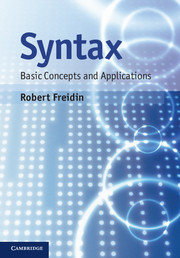Book contents
- Frontmatter
- Contents
- Preface
- Acknowledgements
- 1 The computational nature of human language
- 2 Knowledge of language as an object of inquiry
- 3 Categories and constituents
- 4 Phrase structure theory
- 5 The structure of clauses
- 6 The syntax of Spec-TP
- 7 Head movement and the structure of root clauses
- 8 Wh-movement
- 9 Ellipsis
- Notes
- Glossary
- References
- Index
5 - The structure of clauses
Published online by Cambridge University Press: 05 November 2012
- Frontmatter
- Contents
- Preface
- Acknowledgements
- 1 The computational nature of human language
- 2 Knowledge of language as an object of inquiry
- 3 Categories and constituents
- 4 Phrase structure theory
- 5 The structure of clauses
- 6 The syntax of Spec-TP
- 7 Head movement and the structure of root clauses
- 8 Wh-movement
- 9 Ellipsis
- Notes
- Glossary
- References
- Index
Summary
In the previous chapter the discussion of phrase structure focused primarily on the structure of NPs, with some discussion of PP and AP. This chapter turns to the phrase structure of clauses, in which VPs constitute a significant part.
The phrase structure of VP
The internal structure of the maximal phrasal projection of V (i.e. VP) is essentially identical to that of the other maximal phrasal projections that have been analyzed in the previous chapters. Thus a V merges first with its complement(s), then with its adjuncts, and finally with its specifier. To see how this works in detail, an investigation of the distinction between complements and adjuncts in VP is required.
In the previous chapter it was simply stipulated that any NP that occurs as an object of a head (e.g. V or P) is a complement. This is axiomatic. In PP the number of complements is limited to just one because P can take only one NP object, whereas a VP may contain up to two because of double object verbs (e.g. give and write as mentioned in Chapter 3 , Examples (24a) and (42a)), which can occur with both an indirect object and a direct object.
Information
- Type
- Chapter
- Information
- SyntaxBasic Concepts and Applications, pp. 80 - 105Publisher: Cambridge University PressPrint publication year: 2012
